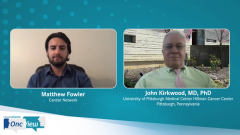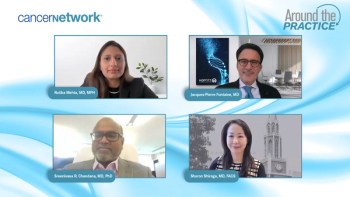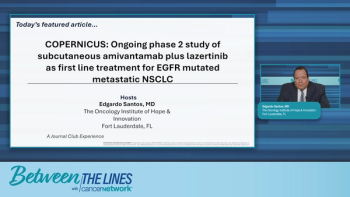
Monitoring Responses to Melanoma Therapy
An expert in melanoma cancer treatment relays the monitoring options for melanoma therapy and gives advice for how long these therapies should be monitored.
Episodes in this series

Matthew Fowler: I wanted to transition to monitoring responses to therapy. In general, what options are there for monitoring a patient on therapy? How do you use each?
John Kirkwood, MD, PhD: Of course, the first that we all have is to do no harm, and to monitor for toxicity is therefore key. We discovered in a neoadjuvant trial of the first-generation checkpoint inhibitor CTLA4 that we could predict which patients, who were going to start ipilimumab, who were at greater risk of colitis by the presence of IL-17 levels at baseline before they received any treatment. Those kinds of markers of inflammation done before treatment may help us mitigate the toxicity of these agents by being able to predict who is destined, and who is likely to have an undue toxicity with these agents.
If we’re using second- and third-generation agents that have a much lower risk of colitis, we have other concerns like the risk for pneumonitis, dermatitis, and hepatitis, which are all significant considerations with PD-1 alone, but also in combination with PD-L1 and LAG3, or PD-1 and TIGIT or TIM3, which are the other third-generation agents coming down the pike. Monitoring for toxicity and potential biomarkers that may predict toxicity are the keys. What we discovered in patients who are being treated with the old first-generation agents, both tremelimumab and ipilimumab, is that the patients who had inflammatory conditions—for instance, in the bowel, diverticulitis, 1 of those that are common out there—were at greater risk of colitis with first-generation checkpoint inhibitors. Those simple historic items need to be carefully checked in each of these patients. Similarly, patients who have arthritides, rheumatoid arthritis, and other autoimmune preexisting conditions may be at increased risk of those toxicities with the checkpoint inhibitors: first-, second-, and maybe third-generation agents as we go forward.
The monitoring of the tumor is something we’ve considered important to treatment. One of the truly promising approaches to monitoring disease response in patients, both on targeted therapies but also on immunotherapies, may be to monitor ctDNA. This is DNA of the tumor that’s circulating in the blood, for which there exist several options for doing molecular testing in the blood over time. It may guide us before we ever see clinical manifestations of relapse to determine who will relapse months ahead of the clinical manifestation. CtDNA monitoring and panels of patients’ own tumor markers that can be monitored are promising ways for the future.
Because many of these therapies are immunotherapies, we have the players of the immune system that can also be monitored. In the tumor, it’s no surprise that the presence of T cells is a predictor of susceptibility to benefit with the checkpoint inhibitors. We’ve known this for many years. The presence of T cells—as Thomas Gajewski [MD, PhD] showed the presence of T-cell transcripts—even at a molecular level in the tumor, for a better outcome in these patients if they had T-cell inflamed tumors. The opposite is T-cell–barren or desert-like tumors where, in the absence of T-cells, many of these agents may have a much more difficult job at achieving an antitumor response.
With this in mind, we’ve taken 1 of the biggest gaps in the field as the target of our therapies. We have multiple trials, which try to stir up the tumor and induce inflammation. T-cell infiltration in the tumor will then allow patients who have failed PD-1 treatments, which are a large category—either with failure to PD-1 or failure to PD-1 plus CTLA4, whom we must deal with. In overview, more than half of patients we treat with PD-1 will have progression. If they’ve acquired resistance and they have initial resistance and refractoriness, there may be different significances that we attribute to the T-cell inflammation.
The other cells that historically have been of interest to us, from the first-generation checkpoint inhibitors, are suppressive immune elements in the tumor. They are known as myeloid-derived suppressor cells [MDSCs], which were discovered in our studies of neoadjuvant anti-CTLA4. They have a huge influence on the susceptibility of the patient to benefit with these agents and equally to other interventions that are immunologic, like the vaccines that are being tested and developed in melanoma as well as many other tumors.
Third, a population of cells known as T-regulatory cells that we have known about for quite some time, are the focus of monitoring studies that we’re doing to try to determine whether our agents may mitigate these populations. We’ve discovered this in the context of PD-1 and PI3-kinase inhibitors several years ago, presented at AACR [American Association for Cancer Research Annual Meeting]. In trials that are underway at our institution [University of Pittsburgh Medical Center Hillman Cancer Center], the combination of PI3 delta gamma inhibitors with PD-1 may restore sensitivity to anti–PD-1 in patients who have previously failed to benefit from PD-1 alone in our population.
There are many options to reverse resistance to PD-1, which is the biggest gap we see in the field. The approach to changing the microbiome. My colleagues Diwakar Davar, [MD], Hassane Zarour, [MD], and our group have shown that can reverse PD-1 resistance simply by changing the microbiome of the gut. It has yet to be done, but it’s obviously an implication of studies that monitoring the microbiome may be important to determining who’s susceptible to benefit with anti–PD-1 agents in the future. That would be a welcome option if we could simply just restore microbial contents that would then add to benefit with the anti–PD-1 agents.
Matthew Fowler: How often do you monitor your patients? You touched on this briefly, but does the monitoring strategy vary according to the therapy type?
John Kirkwood, MD, PhD: Yes, we monitor patients on the protocol, so it’s usually protocol specified. And the intervals, because some of these tests are fairly laborious at monthly or intervals of 3 months, are when it’s possible to do tissue biopsy to assess tumor-infiltrating lymphocyte populations, the presence of MDSCs, T regs [regulatory T cells]. In trials that we’re conducting, where we do a lead-in for a month with 1 or another agent and then proceed with doublet therapy, we may need to do baseline 1-month and then 3-month reassessment of these populations of cells. With the Star Wars approaches to monitoring the cell populations in tumors, we have what’s known as single-cell RNA sequencing, which displays by the transcript profile what the function of each of the cells in a given tumor may be. It tell us whether the intervention with PD-1, or LAG3, or the 2 of them together achieve different ends, achieve different populations—activation that may then be salutary with antitumor benefit in those patients.
This transcript has been edited for clarity.
Newsletter
Stay up to date on recent advances in the multidisciplinary approach to cancer.






















































































